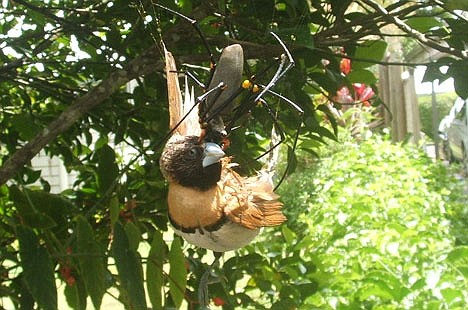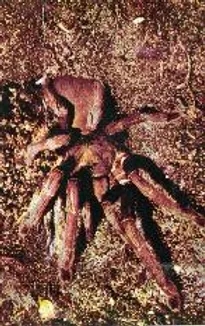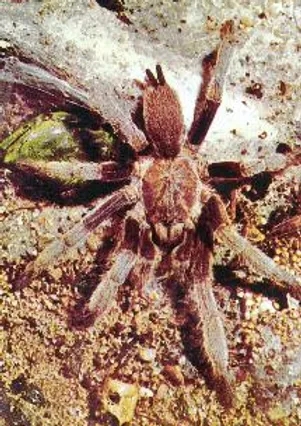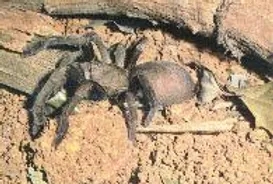For More information on Australian Tarantulas, check out the Australian Tarantula Association.The Bird Eating Spider is one of Australia’s largest spiders belonging to the Trapdoor family. Trapdoor spiders include the Funnel-web, Mouse, Whistling/Bird Eating/Barking, and Curtain-web spiders; they are distinguished by the stocky body, long leg-like palps, and two knee-like lobes to which the fangs join (chelicerae) in front. Most live in burrows with or without trapdoors in the ground, but some live in trees. Trapdoor spiders have powerful chelicerae and four pale patches (the book-lungs) under the abdomen. The correct identification of Trapdoor spiders is often quite complicated.

The Bird Eating Spider is more commonly known as the Australian Tarantula as well as the Barking Spider or Whistling Spider. The barking or whistling sound is a warning when the spider is disturbed and is made by rubbing their palps with their fangs. Selenocosmia crassipes is its Latin name, and it is closely related to the Barking Spiders of South America. This spider is truly a giant as its body reaches the length of 55mm. The male is slightly smaller and slimmer than the female but is still large and powerful. The body of the male grows up to 40mm. The colour of the spider is various shades of rustyBird Eating Spiders kill their prey by pouncing on it and injecting venom. They eat insects, lizards, frogs occasionally, small birds and other spiders (particularly the Lycosa species). All food is captured in the area near their burrows. As they have no teeth, they rely on digestive juices to dissolve their food. This is quite amazing.
The Bird Eating Spider is a type of Trapdoor Spider and they breed similarly to the Trapdoor. The female lives up to 30 years. She spends most of her life in or close to the silk lined burrow. The male lives in a burrow too but leaves it when an adult for mating. The males do not die after mating and can actually survive to breed for two seasons before dying.
The female lays her eggs and sticks the egg sac in a special part of the burrow. The egg sac is 35mm by 30mm and oval in shape. It is thicker at the center and is very white. It’s made of tough silk. The eggs are 2mm in diameter and are translucent. They are a rich yellow colour. The female lays 48 eggs.The female is a devoted mother and carries the egg sac until the young emerge and then cares for them until they leave the burrow.
Bird Eating Spiders kill their prey by pouncing on it and injecting venom. They eat insects, lizards, frogs occasionally, small birds and other spiders (particularly the Lycosa species). All food is captured in the area near their burrows. As they have no teeth, they rely on digestive juices to dissolve their food. This is quite amazing.

The Bird Eating Spider is a type of Trapdoor Spider and they breed similarly to the Trapdoor. The female lives up to 30 years. She spends most of her life in or close to the silk lined burrow. The male lives in a burrow too but leaves it when an adult for mating. The males do not die after mating and can actually survive to breed for two seasons before dying.
The female lays her eggs and sticks the egg sac in a special part of the burrow. The egg sac is 35mm by 30mm and oval in shape. It is thicker at the center and is very white. It’s made of tough silk. The eggs are 2mm in diameter and are translucent. They are a rich yellow colour. The female lays 48 eggs.The female is a devoted mother and carries the egg sac until the young emerge and then cares for them until they leave the burrow.
The amazing pictures of a giant spider eating a bird
If anyone doubted the existence of bird-eating spiders – often depicted in horror movies set in the jungles of South America – the proof is in these amazing photos from Australia.

A huge spider has been photographed tucking into a hapless bird which became entangled in its web – in a family’s back garden!
The pictures were taken earlier this week as the Golden Orb Weaver spider joined the list of other creatures that have made headlines from Australia and the Pacific as they devoured prey – including a fish eating a seagull and a python eating a wallaby.
But no-one expected to come across a garden scene of a bird being devoured by a spider, especially as Golden Orb Weavers confine their daily meal to large insects.
Mr Joel Shakespeare, a spider expert at the Australian Reptile Park said: ‘This particular spider can grow larger than a human hand, so if a bird gets caught in its web I’m not surprised it will start eating it.
’It seems pretty obvious that the poor bird, a chestnut-breasted Mannikin (a type of finch), has flown straight into the web and not been able to free itself before the spider struck.’
Mr Shakespeare said the spider would have used its venom to break down the bird for eating and then wrapped up the pieces in web as a kind of food parcel.
Experts such as Queensland Museum’s Mr Greg Czechura say Golden Orb Weavers build very strong webs, but they point out that the spider would not have struck until the bird became weak as it tried to struggle free.
’The more they struggle, the more tangled up and exhausted they get and they go into stress,’ said Mr Czechura.
’If a spider gets a bird, it’s a very lucky spider.’In other cases of reptiles in the wild attacking other species, a Queensland couple has told how they found a python devouring their dog, just weeks after other snakes killed their cat and guinea pig.
Because the internet is a bastion of horror, you’ve probably become a pseudo-expert in the field of big, terrifying spiders. The Huntsman, a large and seemingly menacing creature found commonly in Australia, became as viral as a spider can get late last year when it was found on someone’s broom and subsequently released by an animal rescue team. Similarly, a Facebook post pinged across the internet last year when another Australian man filmed a Huntsman dragging a dead mouse into its clutches on the side of a refrigerator. As noted before, the internet is a bastion of horror.
Australia Bird Eating Spider: A Glimpse into the World of Giant Arachnids
Australia, the land of exotic wildlife, is home to an array of jaw-dropping creatures, and one such creature that stands out is the Australia bird eating spider. This giant arachnid, also known as the Eastern Tarantula, is a sight to behold due to its sheer size and predatory nature.
Introduction to the Australia Bird Eating Spider
The Australia bird eating spider, scientifically known as Selenocosmia crassipes, belongs to the tarantula family, Theraphosidae. This spider is one of the largest species found in Australia and is renowned for its remarkable size, which can exceed the size of a man’s hand.
In addition to its size, this arachnid possesses a set of powerful fangs, which it employs to subdue its prey. It has a rusty brownish color, which helps it blend into its natural habitats in the warmer and more arid regions of Australia.
Nicknames and Identification
The Australia bird eating spider is also commonly referred to as the Barking Spider or Whistling Spider. These intriguing nicknames stem from the unique sounds the spider can produce. When threatened, the spider is known to generate a hissing or whistling sound by rubbing its palps against its fangs.
Identifying this spider can be tricky. It is characterized by a stocky body, long leg-like palps, and two knee-like lobes to which the fangs join. The spider is usually found residing in burrows, which may or may not have trapdoors.
Habitat and Distribution
The Australia bird eating spider is primarily found in Northern Queensland and Northern Territory. However, there have been sightings of this spider in Southeast Queensland and other parts of Australia as well. The spider prefers warmer climates and thrives in areas with higher humidity.
These spiders are burrowers, and their homes can be identified by the silk-lined burrows they create. These burrows serve as their primary living and breeding spaces, offering them protection from predators and harsh weather conditions.
Diet and Hunting Technique
Contrary to its name, the Australia bird eating spider rarely preys on birds. Its diet primarily consists of insects, other large arthropods, amphibians, and worms. However, due to its size, this spider is an opportunistic predator and is capable of hunting lizards, small birds, and even other spiders if the opportunity arises.
The spider employs a pouncing technique to subdue its prey. It injects its venom into the prey, paralyzing it. As the spider lacks teeth, it relies on its digestive juices to dissolve its food.
Breeding and Lifespan
The lifespan of the Australia bird eating spider greatly varies between males and females. The female spider can live up to 30 years, spending most of her life in or close to her burrow. In contrast, the male spider has a significantly shorter lifespan.
The female spider lays her eggs and secures the egg sac in a special part of the burrow. The egg sac, which is made of tough silk, is usually 35mm by 30mm and oval in shape. The eggs are 2mm in diameter and have a rich yellow color. The female is a devoted mother and carries the egg sac until the young ones emerge. She continues to care for the young spiders until they leave the burrow.

Interaction with Humans
The Australia bird eating spider is not a significant threat to humans. While its bite is venomous, it is not lethal to humans. However, a bite can cause discomfort, including numbness and swelling.
Despite its intimidating appearance, this spider is not aggressive towards humans unless provoked. It is advised not to handle these spiders to avoid any potential risk.
Conservation Status
The Australia bird eating spider is not currently listed as an endangered or threatened species. However, like all wildlife, it is essential to respect their habitats and avoid unnecessary interference.
The Australia bird eating spider is a fascinating creature that truly embodies Australia’s rich and diverse wildlife. This spider, with its unique characteristics and behaviors, contributes significantly to the ecological balance of its habitats. As we continue to explore and understand these remarkable creatures, it is crucial to promote their conservation and respect their existence.
Whether you are an arachnophile, a wildlife enthusiast, or a curious reader, the Australia bird eating spider offers a captivating glimpse into the world of giant arachnids. Remember, these spiders play a vital role in our ecosystem, and respecting their space is the first step towards co-existing with them harmoniously.
